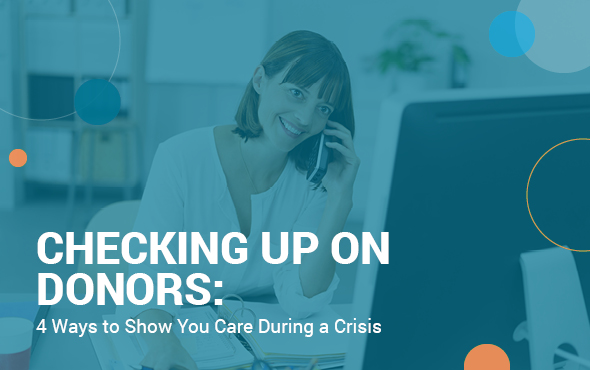Gerard Tonti of Salsa Labs | October 21, 2020
Checking On Donors: 4 Ways to Show You Care During a Crisis
It’s no secret that this year has posed a variety of challenges to nonprofit organizations. Although many months have passed since the COVID-19 pandemic turned the world upside down, most communities are still facing the long-term impact of uncertainty and crisis.
This is undoubtedly true for the internal operations of your nonprofit. You’ve had to adapt your fundraising efforts for the new normal by adopting new technologies and modernizing existing programs.
But it’s also important to consider the impact of the crisis on your supporters. As you know, effective donor retention strategies are built on a foundation of trust and connection. In turbulent times, you should double down on empathetic strategies to reinforce these relationships.
At Salsa, we specialize in helping nonprofit organizations leverage technology to create personal connections with supporters. We’ve seen firsthand how smart engagement strategies can help establish emotional connections with supporters, which should be a primary focus for your organization during the crisis.
Here are four of the best ways to show supporters you care about them during this period of uncertainty:
- Personalize your outreach across platforms.
- Focus on truly listening.
- Demonstrate how they’ve helped your cause.
- Plan virtual events to build community.
A data-driven and emotionally engaging approach to donor relations will benefit your organization both during and after a crisis. But to fully connect with donors, you need tools that provide ample access to the right information and efficient ways to conduct outreach. If you need smarter platforms to power your donor relationships, check out Salsa’s guide to nonprofit software to see the best solutions on the market.
1. Personalize your outreach across platforms.
Individualized appreciation is always key to donor relations, but it’s wise to step it up a notch when you are checking in during a crisis. In your outreach, lean into strategies that create a personal conversation with supporters.
You may not be able to physically sit down with a donor for a heart-to-heart chat, but by personalizing your digital outreach or setting up virtual meetings, you can still evoke an intimate environment for conversation. Challenge yourself to engage in marketing efforts that go beyond using someone’s first name in an email—though don’t stop doing that, either!
You should already have data on record that allows you to create donor segments that enable smart outreach strategies. If you’re looking to expand your audience even further, look for opportunities to connect with even more supporters. For instance, reach out to donors who contributed to your organization through a third-party service like a workplace giving program.
Here are a few ways to conduct crisis-related outreach that shows donors you care:
-
Multiplatform interactions. Ensure you are keeping up with donors on their preferred communication platform. In addition to standard channels like email, try to incorporate new platforms like Facebook Live. If your supporters are tagging or posting about your organization on social media, don’t forget to respond! You can also encourage your nonprofit’s board members and employees to chime into online conversations. This adds a personal touch to what may feel like the faceless presence of your organization’s branded page.
-
Hyper-personalized details. Now is a perfect time to make use of the wide variety of personal information available in your donor database. Depending on the data you have available, you can reference or ask questions about a supporter’s job, family and pets, or even a recent event that they attended. But don’t go overboard—a little bit of personal information goes a long way when making someone feel seen, but too much can feel intrusive.
-
One-on-one conversation. A phone call is a tried-and-true way to have an intimate conversation with donors. When you call, be sure the first thing you do is ask how that supporter is doing. Make their well-being your first priority. You could also conduct mobile outreach through a texting service, social media messaging, or video calls.
These strategies are just the starting point for a productive conversation. In order for these conversations to lead to long-term impact, be sure to incorporate one or more of the other tips on this list.
2. Focus on truly listening.
Once you’ve opened up a communication channel (whether via phone, chat, social media, or on another platform) establish rapport through personal communication then dive a bit deeper. Checking in with donors should focus more on what they have to say rather than what you have to say.
Create a space that allows the donor to feel comfortable sharing their thoughts and concerns about the crisis and your organization’s reaction to it. Ask open-ended questions and listen to their answers. If you are worried about seeming opportunistic during a time of financial hardship, then you aren’t asking the right questions.
Hopefully, the conversation will flow naturally. But if not, here are a few ideas to get the ball rolling:
- Ask them how they’re holding up.
- Explain the safety procedures you’ve put in place to keep supporters, staff, and constituents safe during COVID-19.
- Inquire about what you can do to increase their engagement.
- Tell them about the upcoming opportunities they can participate in (virtual events, campaigns, etc.)
- Ask for feedback about the latest activity or event they attended.
Successful donor relationships should feel relational, not just transactional. This is especially critical in times of chaos when your supporters are dealing with unusual circumstances and financial pressures. They should feel reassured that they mean more to your organization than just dollar signs, and open dialogue will help.
A relationship-first approach to communicating with donors is ideal, but that’s not to suggest fundraising doesn’t matter. While putting time and effort into these connections during a crisis may or may not lead to immediate contributions, they do cultivate long-term giving for a more sustainable fundraising strategy.
According to the Fundraising Effectiveness Project, the average donor attrition rate is 57%. By establishing relationships, you can decrease this metric, increase retention, spend less on acquisition, and raise more in the long run.
3. Demonstrate how they’ve helped your cause.
Continue to center your conversation about the donor, but instead of focusing on how they’re currently being impacted by the crisis, change directions to discuss their past and potential impact on your mission. This will demonstrate how appreciative you are for the individual’s contributions to your organization before, during, and after the crisis.
Provide detailed information about how the donor has made a difference. This will vary from organization to organization, but providing a concrete example is helpful when possible. Translating dollar amounts into resources and initiatives improves transparency and fosters a stronger connection between the donor and your cause.
This is helpful in both one-on-one conversations and communications as well as more public forums where you address your community as a whole. If speaking with an individual, tailor your information to the specific amount they have contributed. If posting publicly, provide an aggregate metric for a set period, like the last week or month.
For instance, if your nonprofit works to address food insecurity, explain how many families the donor has helped to feed with their $500 donation. Or if you’re an animal shelter, post on Facebook about how many dogs you’ve been able to find homes for in the last month. For more examples of ways to communicate donor impact, consult thank-you letter templates like from Fundraising Letters.
The goal here is to emphasize your gratitude for their support, not to make an additional ask. However, some supporters may feel motivated to donate, so be prepared to direct them to your online fundraising platform to streamline their giving process.
Depending on the nature of your organization, you can also provide data related to virtual volunteering to show how your donors are making a difference and how they can continue making a difference without contributing financially.
4. Plan virtual events to build community.
Although events like volunteer days and fundraising galas are out of the question, you can still find ways to facilitate community involvement in a remote setting.
And you don’t have to feel overwhelmed by planning big virtual events like online fundraisers (for a great guide to virtual events, click here). Even smaller-scale events can prove to your donors that you care about investing in your community.
Here are a few ideas for gathering your supporters in a digital space:
- Virtual happy hours or networking
- Webinar or Q&A session with your organization’s director
- Virtual conferences
- Live interviews with constituents who have been helped by your organization
Virtual events help to maintain supporter engagement with your organization and boost overall well-being for your community.
During a crisis, your nonprofit must show compassion for your supporters. By taking the time to check in with your most loyal community members, you can encourage engagement with your mission. With these strategies, your organization will be well-equipped to show donors just how much you appreciate them.
About the author:
Gerard Tonti is the Senior Creative Developer at Salsa Labs, the premier fundraising software company for growth-focused nonprofits. Gerard’s marketing focus on content creation, conversion optimization and modern marketing technology helps him coach nonprofit development teams on digital fundraising best practices.

Get Resources and Insights Straight To Your Inbox
Explore More Articles
International Self Care Day
Today, July 24, 2025, we celebrate International Self Care Day, a day dedicated to promoting self-care practices and their numerous benefits for physical, mental, and…
Read ArticleHow the “Big Beautiful Bill” Will Impact Individual Giving and Employer-Sponsored Workplace Giving Programs
The One Big Beautiful Bill was signed into law on July 4, 2025, introducing a range of provisions that will affect how individuals, companies, and…
Read ArticleGet Resources and Insights Straight To Your Inbox
Receive our monthly/bi-monthly newsletter filled with information about causes, nonprofit impact, and topics important for corporate social responsibility and employee engagement professionals, including disaster response, workplace giving, matching gifts, employee assistance funds, volunteering, scholarship award program management, grantmaking, and other philanthropic initiatives.








